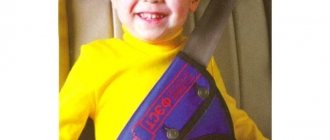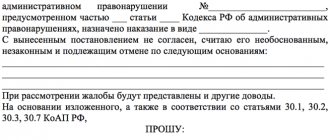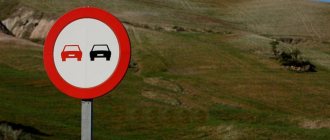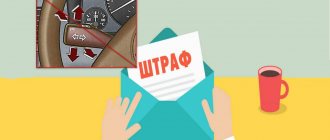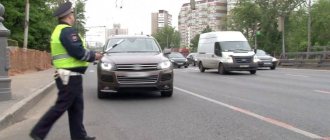If you hit a car from behind, who is to blame? A traffic accident is a very unpleasant event on the road. Usually there are two subjects of an accident - the culprit who caused the collision and the victim. Lawyer practice indicates that when a driver drives into the rear of a car, it is not always his fault.
Most often, during an accident, not all citizens understand the nuances of the event and always panic. In addition, they agree with the conclusions of the traffic police inspector when analyzing the accident and determining the culprit of the incident.
The article is intended to explain all the legal subtleties and specifics of this type of accident, to indicate what the possible reasons for its occurrence may be, and whether the driver who drove into the rear bumper is always at fault. After reading the material, the reader will know how to drive on the road and how to avoid trouble.
What does the traffic rules say if you overtake a car during an accident?
The accumulated experience of Russian auto lawyers involved in handling situations related to traffic violations indicates that you should not make hasty decisions (when a similar incident occurred) and immediately admit your guilt and pay off the damage caused.
To begin with, let's give a definition of traffic rules - this is a legal document designed to regulate not only the movement of vehicles, but to resolve all controversial issues that may arise in the event of a traffic accident between drivers.
For each specific case, this set of rules contains the appropriate formulation of what actions should be taken in a particular emergency situation.
In order to avoid colliding with the car ahead, you should adhere to the requirements and recommendations that are prescribed in the Rules.
Food for thought
Let us turn to section No. 9 “Location of vehicles on the roadway”, paragraph 9.10: “... the person driving the car must maintain such a safe distance in relation to the vehicle in front so that during emergency braking it is possible to avoid a collision with it. The same applies to the lateral interval.”
The essence of this postulate is that when you are driving on the road, the distance to the car in front should be such that if it starts to brake, the driver behind has the opportunity to slow down in time.
It is impossible to stop any vehicle by instantly pressing the pedal. This is achievable if it crashes into an obstacle (tree, wall). Therefore, maintaining a certain traffic distance when driving is the most important factor for safe driving, both in the city and outside it.
Clause 1 of Section 10 of the Rules says at what speed you can drive on the road, “... the vehicle must move in the mode that is established in this area, taking into account weather conditions, traffic congestion, technical condition of the vehicle, visibility and weight and character transported cargo."
The selected speed should provide the driver with the opportunity to constantly monitor the situation around him, so that if there is a risk of an accident, he can reduce it or stop driving, preventing a collision.
Expert commentary
Selivanov Alexander Andreevich
Lawyer, specialization civil law.
Ask a question
Therefore, when on a suburban highway or an intersection in the city one of the cars is driven into the rear and it is necessary to determine who is to blame, first of all, it is necessary to carefully study what happened, based on the norms prescribed in the Rules, taking into account all objective and subjective reasons.
What does the law say?
On the one hand, clause 9.10 of the Traffic Rules clearly states that any moving vehicle is required to maintain a distance on the road.
At the same time, they do not specify exactly what distance, but they say that it should be safe for the vehicle in front. In addition to this, clause 10.1 of the same Rules also determines the speed of movement. It must be safe and sufficient to control the situation and smoothly reduce speed, right down to a complete stop.
The traffic rules clearly establish rules for maintaining distance
It turns out that these two points clearly establish the blame for the cars moving behind (in the event of an impact with the rear of the car). However, in fact, this is not always the case, and drivers have some loopholes to prove they are right. How to determine who is to blame for an accident?
Cases when the driver behind is not at fault
Engine accident, who is to blame? There are situations in life when, in a collision, a motorist who has driven into the rear bumper of a car will be found not guilty.
This can be influenced by several factors, but first of all, it is the actions of the driver driving ahead that must be taken into account.
Indicate in which case in an accident the driver behind the train is not to blame.
Situations can be identified:
- The car ahead suddenly stopped moving due to unforeseen circumstances (it hit an obstacle or another vehicle).
- The one who drove into the rear was hit first.
- Group clash.
Let us analyze each of the indicated cases in more detail so as not to make mistakes in practice. The first thing you should do is not to panic and evaluate everything soberly.
It’s good when there was a camera (video recorder) working in the cabin, which can clarify the investigation process and speed up the identification of the culprit.
Hitting a car in front
This is one of the most common situations, let's analyze it in detail. In accordance with clause 9.10 of the Russian Traffic Regulations, the driver must always maintain a safe distance so that in the event of sudden braking, an accident can be avoided.
What is this concept and how is it interpreted in specialized scientific literature and reference books?
This is the distance between cars moving along the road at approximately the same speed in one direction, which allows the driver moving behind to avoid a collision with another car in the event of a sudden stop.
When driving, everyone will use the standard braking system, which cannot (due to many factors) instantly stop the vehicle.
However, if the next foreign car or truck ahead crashes into an obstacle, fence, infrastructure structure, or another driver, then he instantly stops and cannot continue driving.
The car moving behind (the person driving it) sees a suddenly stopped vehicle in front of it, and because of the accident that has occurred, takes a maneuver or reduces speed to prevent a collision.
However, more often than not, the braking system cannot react every second and an impact occurs in the rear bumper. At the same time, the driver will not be found guilty, since he could not, for objective reasons, suddenly stop driving.
This fact indicates the absence of guilt and in most cases there will be no administrative liability.
The person who drove into the rear was first hit from behind
To understand this situation, it is necessary to consider it with a specific example.
Three cars were moving along the highway, in the same direction. The first of them, before performing the maneuver, slows down, the second, keeping a safe distance, presses the brake pedal, reducing speed to avoid an accident.
At that moment, the third participant unexpectedly crashed into the bumper of the “second driver” in his car. Due to the impact, his car is carried forward and he hits the first vehicle.
Analyzing this episode, we can state the following: there is one traffic accident, the culprit of which is the owner of the third car, as he did not keep his distance.
Since the second participant in the accident kept a safe distance in accordance with the traffic rules, he could not have crashed into the first one without being affected by the impact of the person responsible for the accident.
After all, it was he who provoked the clash. The third driver did not comply with the requirements of current regulations and caused an accident, which caused damage to two more cars.
If the driver was hit in the ass later
Not everything is interpreted unambiguously here, so we will consider this case based on existing legal practice.
The first driver slows down, and the second, not keeping a distance, crashes into him. The car following behind hits the one in front, since the vehicle in front of it suddenly stopped moving.
In fact, there is a group collision between three traffic participants. How to understand such an extraordinary and complex situation at first glance?
It is obvious that the second driver is at fault, since he did not comply with traffic rules - he did not take into account the safe distance to the car in front. The third driver could not stop in 1-2 seconds, since an accident occurred ahead and an unexpected obstacle arose.
Then, as a result, the guilt will be recognized with the second participant in the group clash.
However, the third party involved in the accident may also be guilty. The degree of his responsibility may arise from a number of factors that may influence the final decision.
Such circumstances include:
- what is the time interval between the first and second collision;
- was there a safe distance between the last two cars;
- weather conditions and speed of all participants are taken into account;
- whether the third motorist was distracted while driving;
- Are there any DVR recordings?
Carrying out all the necessary examinations at the scene of the incident will thoroughly answer any questions that arise after this type of accident occurs. Taking into account all subjective and objective factors, it is possible to accurately reconstruct the picture of the accident.
Common conflict situations
The same situation can be attributed to the very common option with tinted rear brake lights . If you crashed into a car driving in front of you because you didn’t see the signals under the tint, you will still be the culprit. As revenge on the real culprit, you can demand a fine for tinting, but no more.
Riding on the studded tires of the person in front also does not relieve you of responsibility. However, as practice shows, if it is proven that the first person has not changed his shoes and there is no “studded tires” sign , in court proceedings the fine for failure to keep the distance is often divided between both parties by 750 rubles . If there is a sign, then the blame is entirely on you. It is also worth noting that the absence of a “studded tire” sign is not a violation, but in rare cases it will help to avoid punishment or mitigate it.
When the car in front is at fault
Such accidents often happen on the roads. Often, a vehicle ahead or standing can provoke a serious accident, often with very serious consequences.
This may happen in the following cases:
- The driver was reversing and crashed into a moving car.
- An incorrect maneuver of the vehicle occurred (automatic set-up).
- The vehicle was in the wrong place on the highway and was poorly visible due to limited visibility by other road users.
In almost all of these cases, the vehicle in front will be at fault. However, we will consider each of these cases in more detail, referring to the current legislation regulating this type of offense.
The front one was moving backwards
The traffic rules specifically state that such a maneuver is classified as complex and requires professional driving skills and increased driver attentiveness.
Clause 8.12 of Section No. 8 of the Traffic Regulations indicates that driving in reverse, provided that the car does not interfere with other participants and does not affect their movement and maneuvering.
However, the Rules provide language when this is prohibited. You can't back up at intersections like that. In addition, such a maneuver cannot be done in places where turning is prohibited.
In accordance with clause 8.11 of the Traffic Regulations of the Russian Federation, this is prohibited:
- At pedestrian crossings.
- At intersections and bridges.
- In the tunnel and highway.
- At railway crossings and at stops.
- On overpasses and overpasses.
- Where visibility on the road is less than 100 meters.
Therefore, if the car was backing up and hit the car, the culprit will be the one who violated the traffic rules.
Note! When driving backwards, you need to control the situation, be extremely careful, move at a very low speed, and if necessary, turn on your hazard lights or honk.
Auto setup
This is not uncommon on modern Russian roads. Therefore, while driving you need to be extremely careful.
The best way out of trouble is to record the video recorder and call the traffic police. In such situations, there is always reason to suspect a criminal conspiracy among attackers, because there is more than one gang of scammers operating on the road.
In such situations, the main thing is not to get lost and not to give in to their persuasion. And if they start to “press”, you need to call the police and write a statement.
A typical case of an accident on the road is when the driver suddenly cuts off the car and exposes his rear. As a result, a collision occurs. Here the only salvation will be the video recorder and witnesses of the accident.
The vehicle was parked in the wrong place
This means when it is parked where it is prohibited to stop, as it interferes with other vehicles. These can be the sides of narrow roads, tram tracks.
For example, a heavy truck is in an area with limited visibility.
When such a collision occurs with a stationary vehicle, it is not uncommon to occur in an area with limited visibility. Often the driver does not see an obstacle in front of him at the last moment.
Therefore, the one who left his SUV or bus on the side of the road, which caused the emergency, will be found guilty.
In what cases is the driver of the car in front at fault?
There are 3 common situations in which when two cars collide, the one in front will be at fault.
The most popular place for such an accident, where the car behind crashes into the one in front, is considered to be an intersection or pedestrian crossing. A situation where a car decides to move into an adjacent area in order to turn off the main road is not uncommon.
This usually happens like this: the driver of the car in front suddenly brakes without seeing the red traffic light, or allows a pedestrian to pass. As a result, the motorist driving behind does not have time to react and crashes into the first car.
The second version of the accident, where there will be no fault behind the driving car: when the driver, being in front, tried to change lanes from one lane of the road to another, and the rear car drove into the bumper. This accident has two development options:
- The car driving in front abruptly changes lanes into the lane you are driving in and brakes sharply for various reasons (for example, a steering problem or the brakes are stuck).
- A car that is standing on the side of the road quickly enters your lane and you do not have time to brake. As a result, a collision is inevitable.
The third option for an accident, which is gaining popularity, is a “set-up” from the driver of the car in front.
The owners of such vehicles are trying to make money from people who are attracted to their maneuvers. They deliberately brake sharply or change lanes. In such cases, you can prove your innocence only with the help of a video recorder.
Is it possible that the rear driver is not to blame if the front driver brakes for no reason?
Emergency braking is one of the actions permitted by the Rules, designed to prevent a possible accident (Section 10.5 of the Traffic Regulations).
However, it is prohibited to brake suddenly or unintentionally on the road, as this may confuse or threaten the safety of other road users. In simple terms, you can only brake sharply in emergency cases.
In the situation under consideration, if the first driver braked without reason, he will be found guilty, provided that a violation on his part is proven.
The second participant in the accident, who drove into his bumper, will also be held administratively liable, as he did not maintain a safe distance while driving.
Therefore, when a driver crashes into the bumper of another car that applied emergency braking to prevent an accident, the culprit will be the second participant in the collision, who does not maintain the required distance.
In this case, the first driver must prove that an accident really could have happened and he sharply reduced speed or stopped.
Braking for no reason
Some unscrupulous drivers, wanting to profit from others, deliberately arrange an accident so that gullible people will compensate them for the damage. They simulate a sudden braking situation, causing you to crash into the bumper of someone else's car from behind.
This issue should not be resolved without traffic police authorities. In addition, it is important to have a video recorder so that you can record what is happening.
What to do if found guilty
This often happens on Russian roads. Police officers may take a careless and one-sided approach to the performance of their official duties and, without fully understanding it, impose a fine for failure to maintain a distance on a driver who has driven into the rear bumper of a moving car in front. Not all citizens understand what to do in this case.
It is necessary to explain in as much detail as possible everything that happened, provide facts and testimony of witnesses.
A DVR recording will undoubtedly help clarify the situation. If the data contained in the protocol does not correspond to reality, you can make notes when signing it, referring to the lack of proof of guilt.
When this does not work and the inspector has issued a decision to impose administrative liability or issued a receipt for payment of a fine, you must write a complaint to the city or district court within 10 days to challenge this decision.
The court, having begun proceedings, will usually resolve the disputed case. If you are aware of incompetent performance of your functional duties by traffic police officers, you can complain to the Internal Affairs Directorate of the Ministry of Internal Affairs of the Russian Federation or submit an application to the Prosecutor's Office.
How much is the fine for distance today?
The Code of Administrative Offenses does not provide for financial sanctions specifically for this traffic violation. We are talking about violating the location of cars on the road.
The amount of the fine in 2021 for failure to keep the distance is 1,500 rubles (Part 1 of Article 12.15 of the Code of Administrative Offenses of the Russian Federation).
Now let us explain where and what the fine comes from? Those at fault are not punished for simply driving into the rear of the car in front. A fine is issued for failure to maintain a distance to avoid a collision with another vehicle - in accordance with clause 9.10 of the traffic rules.
Example
The Logan driver is driving behind a Nissan car in one lane. Suddenly, the driver ahead urgently presses the brake. As a result of this maneuver, the Logan driving behind crashes into the Nissan bumper. That is, an accident occurs due to the fact that the first driver did not maintain a safe distance and did not take into account the requirements of clause 9.10 of the traffic rules. The traffic police officers who arrived at the scene of the incident will issue a fine to the driver of the Logan, and insurers will have to compensate for the damage to the owner of the Nissan car.
Yes, in most cases the culprit is the one who was driving behind and collided with the vehicle in front. And it doesn’t matter what the distance was between the cars. The fact of the accident is enough.
By the way, nothing is said in the traffic rules about the exact distance - there is only a requirement to maintain distances from other moving participants in order to avoid a collision.
There are also explanations here. For example, clause 10.1 of the traffic rules requires taking into account various conditions: driving speed, traffic on the road, vehicle condition, weather conditions, etc. It is logical that the braking distance on an icy road will be longer than on dry asphalt. This means the driver will have to keep an even greater distance. This should be remembered - all this is directly related to distance.
Is there a discount?
Yes, if no harm is caused to the health of the victims of the accident.
If you hit the rear of a car in front, but no one was injured in the accident, you can pay the fine with a 50% discount. The main thing is to meet the 20-day deadline for payment. In total, with the discount, the fine for failure to keep the distance will be 750 rubles.
You can make payment in any convenient way: through the MADI website, Autocode, State Services, bank cash desk or by sending an SMS message (for some mobile operators).




